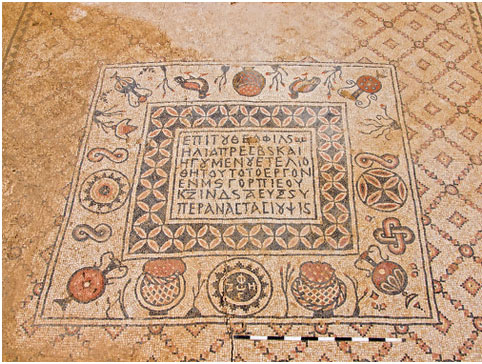Thanks to plans for a new highway in the Northern Negev area, an Israel Antiquities Authority salvage excavation has uncovered an impressive monastery dating to the Byzantine period. The structure, measuring 20 × 35 meters, is divided into halls built along an east–west axis.

“It seems that this monastery, located near the Byzantine settlement of Horbat Hur, is one monastery in a series of monasteries situated alongside a road that linked Transjordan with the Be’er Sheva‘ Valley,” says Daniel Varga, excavation director on behalf of the Israel Antiquities Authority.
Archaeologists uncovered a prayer hall paved with a magnificent mosaic “carpet” featuring a pattern of leaves in blue, red, yellow and green colors. They also found a colorful mosaic on the dining room floor depicting floral motifs, geometric decorations, amphorae, baskets and even a pair of birds.
Another mosaic carpet includes four Greek dedicatory inscriptions denoting the names of the monastery’s abbots: Eliyahu, Nonus, Solomon and Ilrion, and the dates when the pavements were constructed in the different halls. These inscriptions also aided archaeologists in dating the monastery to the second half of the sixth century CE.
The Israel Antiquities Authority, together with the Netivei Israel Company, Hura municipality and Wadi Attir Association, plan on relocating the monastery, including its mosaics, to the Wadi Attir agricultural/tourism project adjacent to Hura.
Fighting for Israel's truth
We cover what makes life in Israel so special — it's people. A non-profit organization, ISRAEL21c's team of journalists are committed to telling stories that humanize Israelis and show their positive impact on our world. You can bring these stories to life by making a donation of $6/month.





